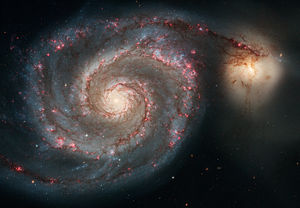- NGC 5195
-
NGC 5195 
A Hubble Space Telescope (HST) image of Messier 51. M51A (the Whirlpool Galaxy) is the spiral galaxy on the left. NGC 5195 is the galaxy in the top right corner.
Credit: HST/STScI/AURA/NASA/ESA.Observation data (J2000 epoch) Constellation Canes Venatici[1] Right ascension 13h 29m 59.6s[2] Declination +47° 15′ 58″[2] Redshift 465 ± 10 km/s[2] Distance 25 ± 3 Mly (7.7 ± 1.0 Mpc)[3] Type Amorphous or SB0 pec[4] Apparent dimensions (V) 5′.8 × 4′.6[2] Apparent magnitude (V) 10.5[2] Other designations Messier 51B,[2] UGC 8494,[2] PGC 47413,[2] Arp 85[2] See also: Galaxy, List of galaxies NGC 5195 (also known as Messier 51b or M51b) is a dwarf galaxy that is interacting with the Whirlpool Galaxy (also known as M51a or NGC 5194). Both galaxies are located approximately 25 million light-years away in the constellation Canes Venatici. Together, the two galaxies are one of the most famous interacting galaxy pairs.
Contents
History
NGC 5195 was discovered by Pierre Méchain in on March 20, 1781.[5]
Interaction with the Whirlpool Galaxy
NGC 5195 and the Whirlpool Galaxy comprise one of the most noted interacting galaxy pairs in astronomy. The two galaxies are listed in the Atlas of Peculiar Galaxies as one of several prominent examples of a spiral galaxy with a companion galaxy.[6] The system was also the subject of very early theoretical investigations into galaxy interactions.[7] The two galaxies are connected by a dust-rich tidal bridge. The dust in this tidal bridge can be seen silhouetted against the center of NGC 5195. This demonstrates that NGC 5195 appears to lie behind the Whirlpool Galaxy.[4] The encounter has significantly enhanced the spiral structure of M51.[citation needed]
Morphology
As a consequence of the gravitational interaction with the Whirlpool Galaxy, NGC 5195 is highly distorted. Classification of its morphology is difficult, as it is sometimes identified as a lenticular galaxy or as an amorphous or irregular galaxy.[4] It has been described as falling outside the standard morphological classification system.[4]
Supernova
Supernova 1945A is the only supernova that has been detected within NGC 5195.[2] The supernova was found 10″ northwest of the nucleus on April 6, 1945 by Milton L. Humason using the 100-inch (2.5 m) telescope at Mount Wilson Observatory. The supernova, classified as a Type I supernova, reached a peak apparent magnitude of 14.0.[8]
See also
External links
- "NGC 5195 at ESA/Hubble". http://www.spacetelescope.org/images/html/heic0506a.html. Retrieved 2011 November 08.
References
- ^ R. W. Sinnott, editor (1988). The Complete New General Catalogue and Index Catalogue of Nebulae and Star Clusters by J. L. E. Dreyer. Sky Publishing Corporation and Cambridge University Press. ISBN 0-933346-51-4.
- ^ a b c d e f g h i j "NASA/IPAC Extragalactic Database". Results for extended name search on NGC 5195. http://nedwww.ipac.caltech.edu/. Retrieved 2006-12-07.
- ^ J. L. Tonry, A. Dressler, J. P. Blakeslee, E. A. Ajhar, A. B. Fletcher, G. A. Luppino, M. R. Metzger, C. B. Moore (2001). "The SBF Survey of Galaxy Distances. IV. SBF Magnitudes, Colors, and Distances". Astrophysical Journal 546 (2): 681–693. arXiv:astro-ph/0011223. Bibcode 2001ApJ...546..681T. doi:10.1086/318301.
- ^ a b c d A. Sandage, J. Bedke (1994). Carnegie Atlas of Galaxies. Washington, D.C.: Carnegie Institution of Washington. ISBN 0-87279-667-1.
- ^ "SEDS: NGC 5195". http://www.seds.org/messier/xtra/ngc/n5195.html. Retrieved 2007-10-13.
- ^ H. Arp (1966). "Atlas of Peculiar Galaxies". Astrophysical Journal Supplement 14: 1–20. Bibcode 1966ApJS...14....1A. doi:10.1086/190147.
- ^ A. Toomre, J. Toomre (1972). "Galactic Bridges and Tails". Astrophysical Journal 178: 623–666. Bibcode 1972ApJ...178..623T. doi:10.1086/151823.
- ^ M. L. Humason (1945). "Supernova in NGC 5195". Publications of the Astronomical Society of the Pacific 57: 174–175. Bibcode 1945PASP...57..174H. doi:10.1086/125712.
Categories:- Irregular galaxies
- Interacting galaxies
- Peculiar galaxies
- LINER galaxies
- M51 Group
- Canes Venatici constellation
- Messier objects
- NGC objects
- UGC objects
- PGC objects
- Arp objects
Wikimedia Foundation. 2010.
